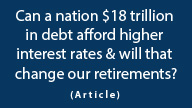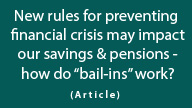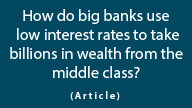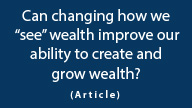Is There A New Global Consensus About Cheating Investors To Reboot Employment?
By Daniel R. Amerman, CFA
Below is the 2nd half of this article, and it begins where the 1st half which is carried on other websites left off. If you would prefer to read (or link) the article in single page form, the private one page version for subscribers can be found here:
Perhaps the real bottom line is that we face a deeply uncertain future. It could be secular stagnation and a continuation of the path of recent years. Or it could be eventual financial crisis and potential currency and economic meltdown. Or it could be technological advances finding an alternative path out of secular stagnation, through the creation of prosperity.
Nonetheless, there is still enormous information value in this new book, which arguably is neither currently understood nor being taken into account by the great majority of investors on a global basis.
That is, when we consider the full implications of what is being discussed in the document, it goes to the very heart of what underlies modern financial theory – and effectively cuts the foundation out from beneath what is by far the most popular school of investment thought, which is that of traditional stock and bond-based financial planning.
Many of the world's savers and investors have been receiving near-zero interest rates for going on four years now – and we have a group of world-renowned economists recommending to their governments that this be continued on an indefinite basis.
Meanwhile, tens of millions of people continue to purchase stocks and invest in their retirement accounts on the basis that they expect the past to continue to repeat itself – even as these economists are suggesting that we many now be in a very different world than we were in the 20th century, and that our issues with very low economic growth rates may be continuing on an indefinite basis.
Now without future high rates of economic growth – all we're left with is a highly overvalued current stock market.
And there's no particular reason to believe that a strategy of pure precious metals investment will necessarily do well in this environment either, given that long term economic stagnation does not necessarily produce high rates of inflation or financial crisis.
And the longer the world carries on without financial crisis – then potentially the lower the current strong "insurance premium" component that is going into precious metals valuation, meaning ongoing likely negative returns in inflation-adjusted terms.
Unfortunately, then, "secular stagnation" would seem to destroy the rationale for all three of these traditional forms of investment whether we're talking about stocks, bonds or precious metals.
In light of this potential "new norm" of very low economic growth, high unemployment and near zero interest rates, the question must be asked:
Okay, if the long term future does turn out to be economic stagnation, then what – exactly – do I do about it?
Wealth Flows and Currents Analysis
The following is a discussion of the above article within the framework of the "Flows & Currents of Wealth" system for financial and economic analysis, with references to particular chapters which discuss each flow of wealth in more detail (learn more here about a free book on the Currents of Wealth).
Wealth Outflows




Perhaps the most direct and easily seen wealth current is the one that steadily erodes bond holder and saver wealth. It also invalidates many of the assumptions in modern financial theory and conventional financial planning (Chapter Six).
Current Central Bank strategies also create a secondary but still significant resulting wealth current which reduces the net worth of precious metals and stock investors (Chapters Two &Three).
Wealth Inflows




Of further crucial importance, these Central Bank-created currents also dramatically increase the effectiveness of "back door" methods for reducing government debts (Chapter Five).
That is, secular stagnation essentially offers a very attractive political cover, even as it serves two purposes:
1. To attempt to boost employment, which may or may not be successful, but this objective will dominate the speeches and press releases.
2. To slash the costs of government liabilities and reduce government debt costs and levels. And, unlike job creation, the resulting silent transfer of wealth from savers to governments is almost guaranteed of success.
Regardless of whether one believes governments have more than one agenda, however, what is certain is that the wealth outflow of "negative real interest rates" is taking wealth from global savers and investors on a wholesale basis, even as it creates a lucrative current of wealth inflows for banks and other institutional investors (Chapter Seven).
For individual investors who instead pursue a select group of non-traditional strategies, however, then the higher the degree of "negative real interest rates" and the longer they last, the greater and more stable the wealth inflows are likely to be (Chapter Eight).
Wealth Inflows & Outflows Conclusion
In the world of finance, the expression, "One person's loss is another person's gain" rings true more often than many people realize.
In the global effort to fight secular stagnation, the overwhelming majority of publicly released information concentrates solely on the goals of creating badly needed jobs and stimulating economic growth.
What is very rarely addressed is the resulting extraordinary damage to saver and retiree income on a global basis. And to the extent it's addressed at all, it is treated as sadly unavoidable "collateral damage".
What is never discussed are the extraordinary financial fringe benefits for heavily indebted governments and major global financial institutions, as a direct result of the chosen strategies for fighting unemployment.
Indeed, most people may find it surprising that there is anyone who is benefitting financially from the efforts to fight secular stagnation, but as reviewed in the wealth outflows and inflows analysis above, there are some major financial beneficiaries of these policies.
The implications for individual investors so powerful that they are likely to determine retirement dates and lifestyles for millions of people, as those following traditional investment strategies must go up against an enormously powerful current of wealth that has been created as a matter of policy, potentially for many years to come. To reverse this situation and turn fundamental outflows of wealth into inflows requires the utilization of non-conventional strategies.
 What you have just read is an "eye-opener" about one aspect of the often hidden redistributions of wealth that go on all around us, every day.
What you have just read is an "eye-opener" about one aspect of the often hidden redistributions of wealth that go on all around us, every day.
 A personal retirement "eye-opener" linked here shows how the government's actions to reduce interest payments on the national debt can reduce retirement investment wealth accumulation by 95% over thirty years, and how the government is reducing standards of living for those already retired by almost 50%.
A personal retirement "eye-opener" linked here shows how the government's actions to reduce interest payments on the national debt can reduce retirement investment wealth accumulation by 95% over thirty years, and how the government is reducing standards of living for those already retired by almost 50%.
 An "eye-opener" tutorial of a quite different kind is linked here, and it shows how governments use inflation and the tax code to take wealth from unknowing precious metals investors, so that the higher inflation goes, and the higher precious metals prices climb - the more of the investor's net worth ends up with the government.
An "eye-opener" tutorial of a quite different kind is linked here, and it shows how governments use inflation and the tax code to take wealth from unknowing precious metals investors, so that the higher inflation goes, and the higher precious metals prices climb - the more of the investor's net worth ends up with the government.
 Another "eye-opener" tutorial is linked here, and it shows how governments can use the 1-2 combination of their control over both interest rates and inflation to take wealth from unsuspecting private savers in order to pay down massive public debts.
Another "eye-opener" tutorial is linked here, and it shows how governments can use the 1-2 combination of their control over both interest rates and inflation to take wealth from unsuspecting private savers in order to pay down massive public debts.







If you find these "eye-openers" to be interesting and useful, there is an entire free book of them available here, including many that are only in the book. The advantage to the book is that the tutorials can build on each other, so that in combination we can find ways of defending ourselves, and even learn how to position ourselves to benefit from the hidden redistributions of wealth.























